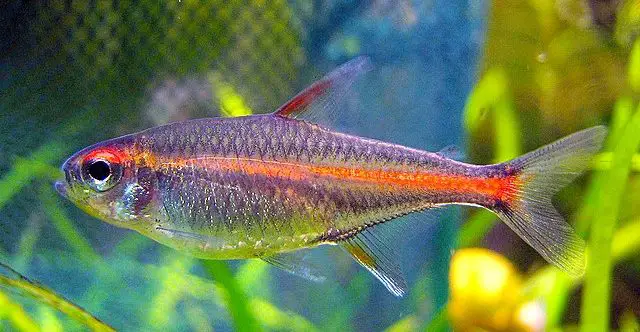Tetra Fish is among the most common and popular tropical fish in fish keeping hobby. The fish is common due to its small size, quiet temperament, low-cost, its colorations, and strong resistance to environment. There are countless types of tetra fish you can choose to house in your aquarium.
Tetras are one of the easiest to care for. And they can be housed with almost any other non-aggressive freshwater fish. The nature and small size of Tetra fish often mean that they will go from school together in the aquarium. This is a necessary quality in freshwater species and can add an excellent effect to any big aquarium.
There are countless tetra species. These species have excellent colorations, animated personalities and are less sensitive to water conditions than other freshwater fish. They grow to the maximum size of 2 inches and can live up to 10 years in captivity if these fish have adequately cared.
Temperature ~ 74 ° F
The most excellent aquarium temperature for Tetras is around 70 ° F – 75 ° F . When you keep any species of tetra fish above 80 ° F, it will generally have a higher metabolism and be more easily stressed. Its lifespan will also be shorter.
pH ~ 6.5 | Hardness 6.0
Keep your pH between approximately 5.5 and 7. Tank-raised Tetras can accept a lower or higher pH depending on the parameters of the stored water. Be sure to check this when buying.
The relative hardness of the water should be four kH to 8 kH. This will reproduce relatively soft conditions similar to those of Amazon.
Maximum size ~ 2 “
Both the male and female tetra fish can grow up to about 2 “.
Nitrite 0ppm
The nitrite should always be 0. High levels can be compact by adding sea plants and increasing the number of water changes in the aquarium. The tetra originates from its namesake, South America. In nature, they are commonly found in rivers, lagoons, lakes, and streams, that is, in the La Plata region. They are freshwater fish and do not do well in conditions that can be very salty or too dirty. Tetra fish swim in schools and are social fish. These fish always travel along with those in their class.
Ammonia 0ppm
Tetras are sensitive to ammonia peaks. They can lose color and breathe quickly.
Neon and Cardinal Tetra Care
On average, Different types of Tetra fish grow 1.5 to 2.0 inches long when they reach adulthood. The male of the species is thinner than the female since the females are a little fat around the belly. The most prized Neon Tetras has bright color in their bodies such as red, white, blue, silver and black, which make for an exciting aquarium. Without a doubt, people enjoy watching tetra fish in school with bright fluorescent colors when they float like a group.
Tetra fish are the ones that eat the most, which means that they eat whatever is on the surface of the water. Therefore, if they do not eat the food offered before three minutes, the food remains will settle in the bottom of the tank. This waste will create a significant amount of organic load and biomass added to that already produced by fish droppings. As a breeder and possessor of these beautiful creatures, you must provide a good quality filtration system to your aquarium to clean the water and make it clean for you tetra fish.
The Neon Tetras are the most environment-friendly. These fish generates less biomass as compared with Betta and Discus. Therefore, they will be reasonably happy with a simple hanging filter (Hang On Back), or a sponge filter, that also takes care of the aquarium nitrogen cycle. An appropriately cycled tank is the only condition that Tetra needs to stay in an aquarium. Let the aquarium water mature for a specific time before adding different types of tetra fish to your tank.
Tetras are one of the most common, most docile, and the least aggressive species of companion fish, and taking care of these beautiful fish is simple. But to ensure good health of these different types of tetra fish, you must follow these checkpoints:
- Keep different types of tetra fish in groups. As they live in a group, in a large school, in their natural habitat.
- If you want to add another variety of fish to your aquarium, then you need to add those fish compatible with tetra fish and other non-aggressive fish.
- Being comfortable in large groups, Tetra can be kept in a medium tank with a good count of compatible tank mates.
- When feeding tetra fish, be sure to give adequate portions, preferably pieces of food, as Tetra favors small bites, or else they will choke themselves with large bits.
- You must maintain the water temperature between 75 and 78 degrees Fahrenheit and place approximately 48 tetra fish for a 20-gallon tank, equipped with a safe water heater if you live in a cold climate and a good-sized aquarium filter.
- Keep the aquarium pH level between 6.8 and a little acid.
- Change the water regularly.
Keeping Tetra Fish
If you are curious about the nature of types of Tetra fish, you will be happy to know that, unlike Betta fish, tetra fish are very sociable. These fish love spending time in the big schools “groups” which is very pleasing to watch. These fish can easily be stressed if they are kept in isolation and can lead to illness and subsequently to death.
A golden rule to know how many tetra fish types are kept together in a gallon of water. Each fish in the aquarium requires at least of 6 inches of space. If you want to know the count of tetra pets in a tank, for example, a 25-gallon tank, a hobbyist should also consider how much water will spill out when you and plants and other decorations. Tetra fish are considered a comparatively small breed that cannot measure more than 2 inches, so the most cooling advice is 45 Tetra fish will be best in a 22-gallon tank, 65 tetra fish in a 28-gallon tank. Different types of Tetra fish accommodated in a 60-gallon tank will be an ideal situation. As a breeder or hobbyist you must keep a minimum of 10 Tetra fish together; otherwise, they may fall ill and die due to seclusion.
Lifespan
The lifespan of tetras is, on average, from 5 to 10 years. The smaller the Tetra, the shorter it’s life.
Tank Setup Guide For Breeding
As Tetra fish are found in warm climates, when kept in an aquarium, the water temperature must be maintained between 68-78 degrees Fahrenheit or 23-26 degrees Celsius. For this temperature to match your water temperature, you will need to provide a suitable heater and a thermometer to regulate and control the water temperature of your tank.
Tetras will lives healthy in somewhat acid waters. They can stand pH between 6.5 to 8, but the best pH for the aquarium is 6.9.
The natural habitat of these brightly colored various types of tetra fish has shaded places and dense vegetation, so they practically live in shades. The bright light may cause stress to your fish and behave abnormally. So to keep your sanity integral and let it continue stress-free. The aquarium should be decorated with plants, branches and floating wood so that you can enjoy an environment similar to their natural habitat, hiding in those dark places of the river.
You must clean the tank properly so that it is clean of biomass or small organic particles. The water should not smell bad. And you must not rinse the aquarium without using any chemical, preferably with hot water.
Breeding Behavior And Pairing
In remote rivers, tetras breeds in the rainy season, when the weather is moist with continuous rain. But when they adjust in an aquarium, they can multiply themselves through the year due to precise conditions of temperature and moisture. Some species of female tetras become active for reproduction at the age of 9-12 months. But in some more abundant species, the actual period of reproduction begins between 1.5 and two years.
The first step for breeding tetra fish is to separate male and female. Although, they must be kept in the same tank using a divider to separate them. Make sure that the divider is a transparent, see-through material for approximately two or three weeks so that they can see their partners and prepare for the future mating and subsequent paternity.
Distinguishing between male and female tetras can be done by their physical look. The males are usually thinner and more colorful than the females, and the females are more plumped and round due to the accumulation of eggs in their body.
Spawning And Taking Care Of Eggs
When the Tetra fish are ready to breed, you must prepare another tank with clean, aged water, live plants, and a peat filter. The female should be placed in the breeding tank one night before breeding and then add the male the next day.
After adding Male, a crucial thing for a breeder is to observe the behavior of the male Tetra fish. Males often show aggressive behavior when attacking females. In such a situation, the female tetra must return to her section in the tank. This will help the male control his aggression and accept his partner next time. Two to three females can be placed in the aquarium so that the male Tetra fish do not have to focus on a female tetra. To provide a reproduction environment, that is similar to wildlife; the tank should be covered with a hardboard with a window that offers a little light and little visibility.
Different types of Tetra Fish
Black Neon Tetra
 The Black Neon Tetra is the best types of tetra fish you can buy. They have a great coloration in their body. These types of tetra fish are mostly kept in a planted aquarium. Where slightly acidic water conditions are present. The Black Neon Tetra has a yellow-green stripe that runs along the body with a black region below the yellow-green strip. It looks great when you see a school of this fish circling. They are very tiny and peaceful fish and should not be kept with aggressive fish that tends to eat them.
The Black Neon Tetra is the best types of tetra fish you can buy. They have a great coloration in their body. These types of tetra fish are mostly kept in a planted aquarium. Where slightly acidic water conditions are present. The Black Neon Tetra has a yellow-green stripe that runs along the body with a black region below the yellow-green strip. It looks great when you see a school of this fish circling. They are very tiny and peaceful fish and should not be kept with aggressive fish that tends to eat them.
These types of tetra fish are available at local pet stores to have been raised on farms and should be relatively free of disease, but you never know. It is always a good idea to store any new types of tetra fish in a quarantine tank for a few weeks to control it before putting it into your main tank. These Tetra fish types can be sensitive to fluctuations in pH and temperature.
Lemon Tetra
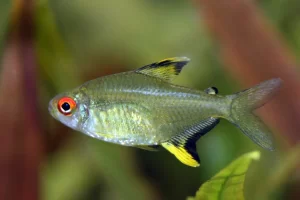 The lemon tetra (Hyphessobrycon Pulchripinnis) is a tetra fish that is very easy to care for, which is tolerable to almost all water parameters that the typical fan keeps. The Lemon Tetra has a small size of no more than two inches (5 cm) and prefers to be in a school of at least 6, which limits them to a minimum tank of 10 gallons. These types of tetra fish can live from 6 to 8 years.
The lemon tetra (Hyphessobrycon Pulchripinnis) is a tetra fish that is very easy to care for, which is tolerable to almost all water parameters that the typical fan keeps. The Lemon Tetra has a small size of no more than two inches (5 cm) and prefers to be in a school of at least 6, which limits them to a minimum tank of 10 gallons. These types of tetra fish can live from 6 to 8 years.
Head and Tail Light Tetra
 The head and light Tetra gain its name from the two spots on the body which reflects light. One area on the head and the rear light Tetra is just behind the eye and the other area at the base of the tail fin. It can be difficult to see this in tanks with lower lighting levels.
The head and light Tetra gain its name from the two spots on the body which reflects light. One area on the head and the rear light Tetra is just behind the eye and the other area at the base of the tail fin. It can be difficult to see this in tanks with lower lighting levels.
Like other tetras, the Tetra Light of the head and tail likes to be in small schools of 6 or more. They are usually peaceful tetra fish types and do very well in aquariums of living plants. Water should be kept slightly on the acid side. Because they come from slower waters in the Amazon basin, it may also be a good idea to give them a slower stream in the indoor aquarium.
Green Neon Tetra
The Green Neon Tetra looks very alike to the regular Neon Tetra, but only reaches about one inch in size. They will do better if they are kept in small schools of 7 or more and slightly acidic and soft water conditions.
Green Neon Tetras are not seen in commerce as often as regular neons or tetra cardinals. Fans sometimes confuse the three species. If you want to test yourself to maintain these tetras, do a slow drip acclimation for an hour or more and eat a high-quality diet and keep the water in the tank in excellent condition, p. Keep nitrates on the low side. They will do great in a heavily planted aquarium.
Glowlight Tetra Fish
The Glowlight Tetra is a very beautiful tetra with an orange-red stripe that runs along its semitransparent body. Adequate levels of aquarium lighting with a dark fish tank bottom can help improve the colors of the Glowlight Tetra. They are slightly smaller than other commonly found tetras. They will do well in an aquarium with live plants. Like other small tetras, such as the Neon Tetras, these tetra fish types have better performance in small schools (shallows) of 5 or more. Do not keep them with more abundant species that could potentially eat them. Even if you keep them in school, they can still be a bit shy, keeping a low profile most of the time.
Ember Tetra
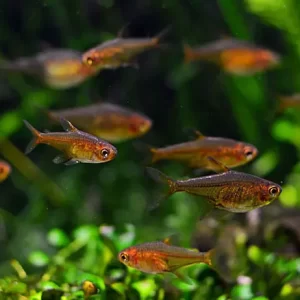 The Ember Tetra (Hyphessobrycon Amandae) is light orange with a semitransparent body. They are small but only reach between 0.75 and 1 inch in size when they are adults. They are found in the basin of the Araguaia River in South America.
The Ember Tetra (Hyphessobrycon Amandae) is light orange with a semitransparent body. They are small but only reach between 0.75 and 1 inch in size when they are adults. They are found in the basin of the Araguaia River in South America.
Keep the Ember Tetra in groups of 5 or more to help promote schooling behavior. This also helps them feel more secure. They look, and they will do very well in a strongly planted tank.
A good meal of good quality small pellets can make up most of your diet. The Hikari and New Life Spectrum granules (1 mm) work well and will be accepted with pleasure.
Disk Tetra
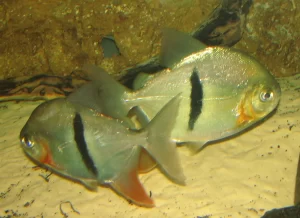 The Disk Tetra (Myleus Schomburgkii) can reach an enormous size as adults, reaching up to 16 inches (42 cm)! You need a huge tank if you plan to keep the Tetra disc.
The Disk Tetra (Myleus Schomburgkii) can reach an enormous size as adults, reaching up to 16 inches (42 cm)! You need a huge tank if you plan to keep the Tetra disc.
It is known that these Disk Tetras have a strong bite (ref: fish base – “It has powerful teething that can cause severe bites”) so be careful when working with older adults.
Most fans should merely approve these types of tetra fish if you see them in the store given their adult potential.
Diamond Tetra
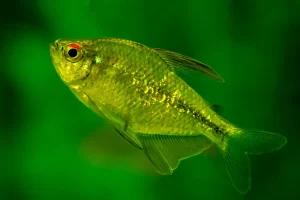 The Diamond Tetra (Moenkhausia Pittieri) gets its common name from the way its scales shine like diamonds under the correct lighting.
The Diamond Tetra (Moenkhausia Pittieri) gets its common name from the way its scales shine like diamonds under the correct lighting.
Diamond Tetras work best in soft and slightly acid waters. Keep them in schools of 5.
The Diamond Tetra measures approximately 2.3 inches (6 cm) and must live several years if it is kept in right water conditions and fed with a proper diet. An excellent small meal in granules can make up most of your diet, but you can also add some frozen thawed foods (like black worms) from time to time.
Cardinal Tetra Fish
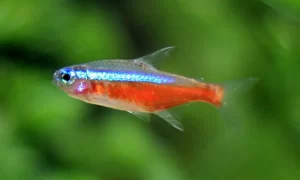 Cardinal Tetra looks very similar to neon tetra and is often confused with it. These types of tetra fish will have the red strip along the entire length of its body in the lower half, while the Neon Tetra will have the red band only in half. These tetras are excellent tank partners in the community and to obtain better results, you must keep them in a school of 6 or more.
Cardinal Tetra looks very similar to neon tetra and is often confused with it. These types of tetra fish will have the red strip along the entire length of its body in the lower half, while the Neon Tetra will have the red band only in half. These tetras are excellent tank partners in the community and to obtain better results, you must keep them in a school of 6 or more.
The cardinal tetra prefers water slightly on the acidic side and to obtain the best results, and you will want to acclimate them very slowly to your tank. Make sure your tank has completed the nitrogen cycle of the aquarium. Give Cardinal Tetra a tank with low light and many aquarium plants.
Bucktooth Tetra
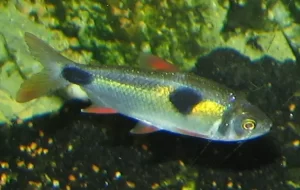 The bucktooth tetra (Exodon Paradoxus) is a kind of a misnomer in the sense that this tetra fish type has no teeth at all. However, eat the scales of other fish species. Caution is advised if you plan to stock them with fish that have scales. According to reports, they do well with catfish species. You need to keep these fish schools of 5 to 7 or more to obtain better results.
The bucktooth tetra (Exodon Paradoxus) is a kind of a misnomer in the sense that this tetra fish type has no teeth at all. However, eat the scales of other fish species. Caution is advised if you plan to stock them with fish that have scales. According to reports, they do well with catfish species. You need to keep these fish schools of 5 to 7 or more to obtain better results.
They are considered quite resistant once established and fed with an excellent quality leaflet or pellet. Several small feeds are recommended per day. The Bucktooth Tetra becomes approximately 2.9 inches (7.5 cm).
Bloodfin Tetra

The Bloodfin Tetra is a pillar of the hobby of freshwater fish and for a good reason. Bloodfin Tetra has silvery bodies with an almost greenish hue (depending on the lighting of the aquarium) and red fins. A great beginner freshwater fish, the Bloodfin Tetra will bear a large kind of water parameters. Some breeders even put them in cold water tanks. They will tolerate a lower temperature than other tropical fish, but use a heater to keep the temperature stable. Avoid fluctuating water temperatures that could stress your tetra fish.
Blind Cave Tetra
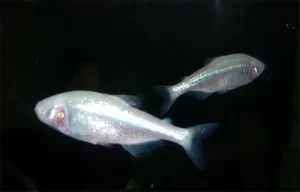 Blind Cave Tetras is a relatively new tetra for the primary guardians of the aquarium. As its name would indicate, the Tetras of the blind cave have no eyes. They are born with fried eyes, but the eyes degenerate and are reabsorbed in the body within a few weeks of life.
Blind Cave Tetras is a relatively new tetra for the primary guardians of the aquarium. As its name would indicate, the Tetras of the blind cave have no eyes. They are born with fried eyes, but the eyes degenerate and are reabsorbed in the body within a few weeks of life.
The Blind Cave Tetra lives in deep caves in nature. They go from Texas to Mexico, with the version for visionaries from Mexico to Panama. There is no need to see the eyes in the black caves, so they have evolved to adapt to these conditions.
Bleeding Heart Tetra
 The Bleeding Heart Tetra is a relatively robust tropical fish and perfect for beginners of freshwater fish that practice proper maintenance of the aquarium. The Bleeding Heart Tetra is very sought after because they are a beautiful fish and primarily because of the small red spot (“heart”) that lies on the sides. This is a reasonably active tetra fish that should bring a lot of activity to your tank if it is kept in a small school (sandbar).
The Bleeding Heart Tetra is a relatively robust tropical fish and perfect for beginners of freshwater fish that practice proper maintenance of the aquarium. The Bleeding Heart Tetra is very sought after because they are a beautiful fish and primarily because of the small red spot (“heart”) that lies on the sides. This is a reasonably active tetra fish that should bring a lot of activity to your tank if it is kept in a small school (sandbar).
Bleeding Heart Tetra will accept most food for tropical fish, including flakes, lyophilized, frozen and live foods. It is acceptable to use dried flakes as your main diet, but try to supplement your fish diet with frozen or live foods time and again.
Black Skirt Tetra (Gymnocorymbus Ternetzi)
 The Black Skirt Tetra has some different common names, such as Black Tetra and Black Widow Tetra. They are very popular with hobbyists and are generally available at most fish shops. As the Black Skirt Tetra grow, some of the black colorations in their body might fade away.
The Black Skirt Tetra has some different common names, such as Black Tetra and Black Widow Tetra. They are very popular with hobbyists and are generally available at most fish shops. As the Black Skirt Tetra grow, some of the black colorations in their body might fade away.
The Black Skirt Tetra can be an excellent addition to a community tank with the right combination of tank mates. Avoid keeping them with fine tweezers known as tiger barbs, and also avoid having them with fish that have larger fins, such as angelfish, because the Black Skirts have been caught biting the fins. Try to keep your Black Tetras in groups of 5 or more to prevent any fin bite at a minimum, or at least between schools.
Black Phantom Tetra
 The Black Phantom Tetra is a tetra with a body with a black diamond patch with a green or silver mark on the two sides of their body. While defending the territory against other black ghost tetras, the male Black Phantom Tetra can acquire a darker color when it is ready to reproduce or when defending its territory in the aquarium. Like other tetras, this is no exception when it comes to wanting to go to school. Plan to keep them in groups of 6 or more. They will develop a hierarchical order among the group. The males can train with each other, but this activity should not cause them significant damage. They should do well in a community setting with smaller and less aggressive species. They like to occupy the middle and lower levels of the aquarium.
The Black Phantom Tetra is a tetra with a body with a black diamond patch with a green or silver mark on the two sides of their body. While defending the territory against other black ghost tetras, the male Black Phantom Tetra can acquire a darker color when it is ready to reproduce or when defending its territory in the aquarium. Like other tetras, this is no exception when it comes to wanting to go to school. Plan to keep them in groups of 6 or more. They will develop a hierarchical order among the group. The males can train with each other, but this activity should not cause them significant damage. They should do well in a community setting with smaller and less aggressive species. They like to occupy the middle and lower levels of the aquarium.




